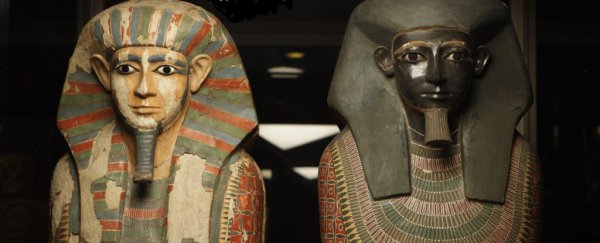Long ago, Egyptians carved a cemetery into a rock wall along the Nile River 250 miles south of Cairo. The cemetery outlasted its 12th Dynasty creators. It survived intermittent pillaging by tomb raiders. And then in 1907, an excavator named Erfai discovered an untouched tomb.
This was an unusual burial site. Within the tomb lay two high-society men, called Khnum-Nakht and Nakht-Ankh, their coffins adjacent.
Hieroglyphs on their 4,000-year-old coffins told part of their story. Each man was described as the son of a woman named Khnum-aa. The burial ground earned the nickname "the tomb of the two brothers."
The two brothers have been on display in Britain, in the Manchester Museum, since 1908. Yet, nearly from the start, experts cast doubt on the men's fraternal relationship.
A team led by anthropologist Margaret Murray, the first female archaeologist to become a lecturer at a British university, argued that "it is almost impossible to convince oneself that they belong to the same race, far less to the same family."
The mummies' skull anatomies were too different, the scholars said. Later, researchers studied scraps of their skin. They agreed with Murray's team – the mummies' distinct complexions suggested these men did not share parents.
No one had it quite right. A new genetic analysis aims to clear up this relationship. Khnum-Nakht and Nakht-Ankh were, as the text on their coffins suggested, mummies from the same mother.
But call it the tomb of the two half-brothers instead: They probably had different fathers.
"We have solid genetic proof that backs up the hieroglyphics, which define the brothers by their mother's name and not the father's name," said Konstantina Drosou, a University of Manchester geneticist and author of a new study in the Journal of Archaeological Science.
A retired dentist, Roger Forshaw, delicately pried molars from the mummies, two from Nakht-Ankh and three from Khnum-Nakht. From the teeth, geneticists extracted DNA.
Khnum-Nakht was the younger half-sibling by 20 years. The hasty way he was mummified indicates he died suddenly; Nakht-Ankh, who probably died a year or so after his relative, was wrapped with more care. (Khnum-Nakht's poorer preservation made DNA extraction particularly difficult, hence the extra tooth required.)
The researchers focused on two types of genetic material. They analysed DNA from mitochondria, the power plants within our cells. In many species, including humans, mitochondria have their own DNA. People inherent this genetic material only from their mothers because egg cells, but not sperm, contribute mitochondria to an embryo.
For the other half of this paternity test, the geneticists peered into the mummies' Y chromosomes – inherited from their fathers.
A previous genetic study, using liver and intestinal samples, suggested that the men weren't at all related. But a new generation of DNA techniques has enabled geneticists to rely on hard tissue, rather than soft, from which Drosou and her colleagues acquired "good quality DNA."
Mitochondrial DNA produced convincing results. "Because we recovered nearly complete [mitochondrial DNA] profiles, we can be very confident that they are maternally related," Drosou said.
Data from Y chromosomes, however, were spottier. But the information was complete enough to indicate that these men probably had different fathers. "Comparisons between six regions of the Y chromosome indicate that possibly they have a different father," she said.
Khnum-Nakht and Nakht-Ankh were not royalty. Each was the son of a local governor, according to the hieroglyphics. A governor was "basically the headman of the local town, making them elite," said Campbell Price, the curator of Egypt at the Manchester Museum who worked with Drosou on the new research. "Most people were farmers, remember."
Price said the discovery suggests an underemphasised aspect of this culture: the role of women in Egyptian high society. Khnum-aa, a member of the "highest social circles," probably had a son with one local ruler and then, two decades later, had a son with another.
"Perhaps," he wondered, "the male local governors were only able to confirm or maintain their power by marrying this woman called Khnum-aa?"
2017 © The Washington Post
This article was originally published by The Washington Post.
